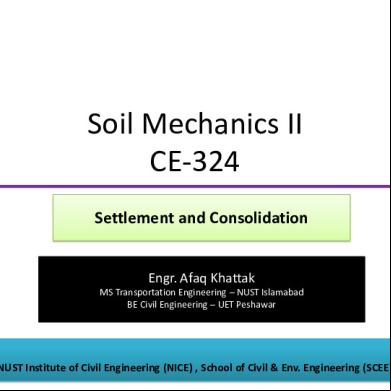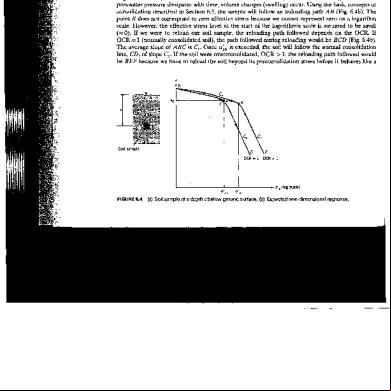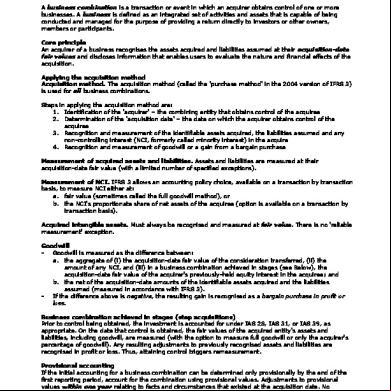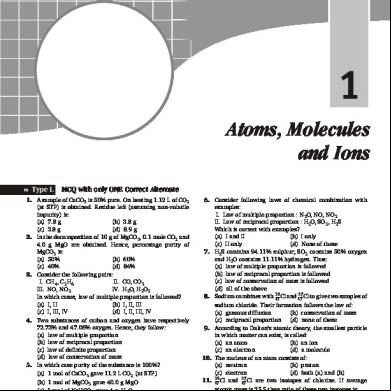Ce324 - 07 Settlement And Consolidation 534m3v
This document was ed by and they confirmed that they have the permission to share it. If you are author or own the copyright of this book, please report to us by using this report form. Report l4457
Overview 6h3y3j
& View Ce324 - 07 Settlement And Consolidation as PDF for free.
More details h6z72
- Words: 447
- Pages: 19
Soil Mechanics II CE-324 Settlement and Consolidation
Engr. Afaq Khattak MS Transportation Engineering – NUST Islamabad BE Civil Engineering – UET Peshawar
NUST Institute of Civil Engineering (NICE) , School of Civil & Env. Engineering (SCEE)
1
2
The Leaning Tower of Pisa
Compression of soil • A stress increase caused by the construction of foundations or other loads compresses soil layers. • The compression is caused by – Deformation of soil particles – Relocation of soil particles – Expulsion of water or air from void spaces.
• In general, the Soil settlement can be divided in three categories – Immediate settlement (elastic settlement) – Primary consolidation settlement – Secondary consolidation settlement
3
Settlement
4
5
Significance • The amount of soil volume change that will occur is often one of the governing design criteria of a project. • If the settlement is not kept to tolerable limit, the desire use of the structure may be impaired and the design life of the structure may be reduced. • It is therefore important to have a means of prediction of the amount of soil compression or consolidation. • It is also important to know the rate of consolidation as well as the total consolidation to be expected.
6
Immediate settlement • Immediate (elastic) or distortion settlement or initial settlement is caused by elastic deformation of dry/moist/saturated soil without any change in the moisture content. • It can be described by Hooke’s law. • It occur immediately upon the application of load or due to the lateral deformation of soil beneath the footing.
• Immediate settlement calculations are generally based on equations derived from theory of elasticity.
7
Immediate settlement calculation
8
m1 = length of foundation / width of foundation
Immediate settlement calculation
9
10
Example
11
Improved relationship for immediate settlement • Mayne & Poulos (1999) recently presented an improved relationship • This relationship takes into – – – –
The rigidity of foundation The depth of embedment of foundation Increase in modulus of elasticity of soil with depth Location of rigid layers at limited depth
Mayne, P. W., Poulos, H. G. (1999) Approximate Displacement Influence Factors for Elastic Shallow Foundations, ASCE Journal of Geotechnical and Geoenvironmental Engineering, Vol. 125, No. 6, 453 – 460.
12
Mayne and Poulos (1999) Method First step is to determine equivalent diameter of a rectangular foundation, which is
For circular foundation,
13
Mayne and Poulos (1999) Method
14
Depth of Embedment of foundation Rigidity of foundation
Increase in Modulus of Elasticity with depth Location of Rigid layer at limited depth
Mayne and Poulos (1999) Method
15
Influence factor IG
16
Influence factor IF
17
Influence factor IE
18
Example
19
Engr. Afaq Khattak MS Transportation Engineering – NUST Islamabad BE Civil Engineering – UET Peshawar
NUST Institute of Civil Engineering (NICE) , School of Civil & Env. Engineering (SCEE)
1
2
The Leaning Tower of Pisa
Compression of soil • A stress increase caused by the construction of foundations or other loads compresses soil layers. • The compression is caused by – Deformation of soil particles – Relocation of soil particles – Expulsion of water or air from void spaces.
• In general, the Soil settlement can be divided in three categories – Immediate settlement (elastic settlement) – Primary consolidation settlement – Secondary consolidation settlement
3
Settlement
4
5
Significance • The amount of soil volume change that will occur is often one of the governing design criteria of a project. • If the settlement is not kept to tolerable limit, the desire use of the structure may be impaired and the design life of the structure may be reduced. • It is therefore important to have a means of prediction of the amount of soil compression or consolidation. • It is also important to know the rate of consolidation as well as the total consolidation to be expected.
6
Immediate settlement • Immediate (elastic) or distortion settlement or initial settlement is caused by elastic deformation of dry/moist/saturated soil without any change in the moisture content. • It can be described by Hooke’s law. • It occur immediately upon the application of load or due to the lateral deformation of soil beneath the footing.
• Immediate settlement calculations are generally based on equations derived from theory of elasticity.
7
Immediate settlement calculation
8
m1 = length of foundation / width of foundation
Immediate settlement calculation
9
10
Example
11
Improved relationship for immediate settlement • Mayne & Poulos (1999) recently presented an improved relationship • This relationship takes into – – – –
The rigidity of foundation The depth of embedment of foundation Increase in modulus of elasticity of soil with depth Location of rigid layers at limited depth
Mayne, P. W., Poulos, H. G. (1999) Approximate Displacement Influence Factors for Elastic Shallow Foundations, ASCE Journal of Geotechnical and Geoenvironmental Engineering, Vol. 125, No. 6, 453 – 460.
12
Mayne and Poulos (1999) Method First step is to determine equivalent diameter of a rectangular foundation, which is
For circular foundation,
13
Mayne and Poulos (1999) Method
14
Depth of Embedment of foundation Rigidity of foundation
Increase in Modulus of Elasticity with depth Location of Rigid layer at limited depth
Mayne and Poulos (1999) Method
15
Influence factor IG
16
Influence factor IF
17
Influence factor IE
18
Example
19










